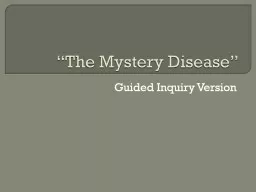PPT-“The Mystery Disease”
Author : phoebe-click | Published Date : 2018-10-24
Guided Inquiry Version Patient Description 1904 In 1904 a student from the West Indies came to a Chicago physician Dr James Herrick with a puzzling condition Below
Presentation Embed Code
Download Presentation
Download Presentation The PPT/PDF document "“The Mystery Disease”" is the property of its rightful owner. Permission is granted to download and print the materials on this website for personal, non-commercial use only, and to display it on your personal computer provided you do not modify the materials and that you retain all copyright notices contained in the materials. By downloading content from our website, you accept the terms of this agreement.
“The Mystery Disease”: Transcript
Download Rules Of Document
"“The Mystery Disease”"The content belongs to its owner. You may download and print it for personal use, without modification, and keep all copyright notices. By downloading, you agree to these terms.
Related Documents














